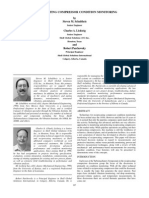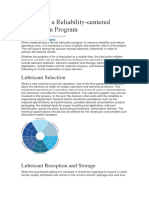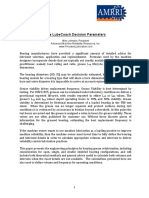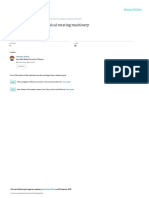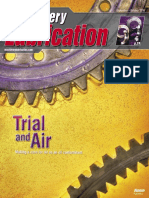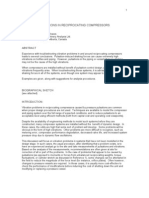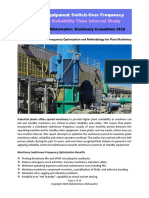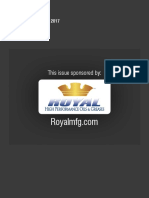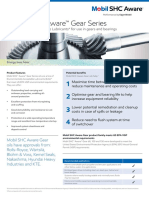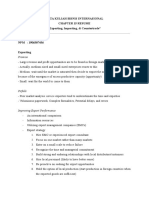Professional Documents
Culture Documents
Technical Topic - Lubrication Program Management
Technical Topic - Lubrication Program Management
Uploaded by
dhavit wijayantoCopyright
Available Formats
Share this document
Did you find this document useful?
Is this content inappropriate?
Report this DocumentCopyright:
Available Formats
Technical Topic - Lubrication Program Management
Technical Topic - Lubrication Program Management
Uploaded by
dhavit wijayantoCopyright:
Available Formats
Technical Topic
Lubrication Program Management
Energy lives here™
A Key to Success Lubrication Management Program Goals
Regardless of industry type, maintaining a safe work place, To properly define the goals of your lubrication management
complying with applicable laws and producing profitable products program, choose from the following list (depending on what best
with maximum quality are all sound objectives for world-class meets your company’s needs):
company. But, what does it take to accomplish these objectives?
To be successful, manufacturers like yourself positively, absolutely, • Reduce lubricant related failures
require maximum equipment availability. • Use the fewest correct lubricants and minimize waste
• Apply the lubricant in the correct manner, at the proper
To make that happens, you need a disciplined, world-class time and in the correct amounts
lubrication program. This can be achieved by establishing some • Integrate the plant’s preventive and predictive maintenance
guiding principles that include: goals into the lubrication program
• Continually investigate and implement methods to improve
Setting the Implementing the and achieve the above goals
Defining the
importance of tools required to
lubrication
a lubrication achieve lubrication
management Once you’ve defined the goals of your lubrication management
management management
program goals
program program goals program, you need to be sure you have the proper tools that will
enable you to achieve these goals. No matter what method you
The Importance of a Lubrication Management Program implement, to ensure success, you should use the following tools.
Most people believe that by just maintaining or adding lubricant
to the rotating equipment provides effective lubrication. However,
by not implementing the lubrication management program, the
opportunity to optimize equipment reliability and maximize the
return on your investment may be lost. Disciplined lubrication
management is the foundation of a world-class lubrication
program. The following chart illustrates the difference made in
a plant’s total cost of ownership once you’ve taken that step.
DESCRIPTION BEFORE AFTER
Annual Lubrication Cost including Labor,
$1,055,000 $845,000
Lubricant Costs and Supply Costs
Total Annual Maintenance Budget $24,000,000 $22,000,000
Percent Annual Lubrication Costs Versus Total
4.4% 3.8%
Maintenance Budget
Lost Annual Availability Due to Scheduled and
6% 2%
Unscheduled Maintenance
Estimated Annual Profit Lost Due to Lost
$3,500,000 $1,200,000
Equipment Reliability
Annual Maintenance Department Overtime 22% 14%
Annual Number of Equipment Failures Due to
18 2
Poor Lubrication
Annual Volume of Lubricant Consumed (gallons) 62,000 15,000
Chart shows example numbers for demonstration purpose only.
Lubrication Program Management
Basic Tools Required for an Effective Program
Leadership Lubrication needs to be a priority for maintenance managers. Be sure to nominate a program
champion — someone who will assume the responsibility, accountability and control for the
program.
Standard Operating Procedures SOPs can help guarantee repeatability and quality work. SOPs also assist in the training of
(SOP’s) lubricators and enable you to track and communicate equipment condition.
Teamwork & Communication A world-class lubrication program must have a team that works and communicates with all
members of the manufacturing group-operations, maintenance, purchasing, planning and
engineering.
Lubrication Scheduling, To handle the quantity of data encountered (even for a small plant), an effective computerized
Planning, and Tracking system should be employed. Without it, important equipment trends may be missed and/or
Management Systems documentation of the lubrication program may be lacking.
Training To continually improve, both program leader and lubricators must continually learn best
lubrication practices, as well as learn new techniques in their specific discipline.
Metrics Knowing the past performance and understanding the effects of program efforts enable
you to evaluate lubrication program-related decisions. Some useful metrics are: 1. Total
maintenance costs and percentage spent on lubrication
2. Percentage of equipment scheduled and unscheduled downtime
3. Number of lubricant related failures
4. Percentage of maintenance overtime labor
5. Lubricant consumption
6. Safety incidents
Audits In order to improve, you need to validate or audit your lubrication program. Whether
performed internally or by a third party, the effort to benchmark and evaluate your lubrication
program against other “best in class” operations will supply tremendous dividends.
Conclusion
Safety, compliance, and maximum quality manufacturing are sound
objectives for a world-class company. A disciplined lubrication
management program is what’s needed to achieve these objectives.
And, when you set goals that help you succeed, you are well on
your way to establishing a world-class lubrication program.
Refs: “Lubrication Management: A Key to Success” By Tom Schiff
The Engineered Difference — Winter 2001
© 2019 Exxon Mobil Corporation. All rights reserved.All trademarks used herein are trademarks or registered
trademarks of Exxon Mobil Corporation or one of its affiliates unless otherwise noted. mobil.com/industrial
You might also like
- Mla 2Document374 pagesMla 2Mohsin Murtaza100% (2)
- LCE Lubrication Self-Assessment ToolDocument1 pageLCE Lubrication Self-Assessment ToolPatrick FoNo ratings yet
- CMRP Exam Study ResourcesDocument2 pagesCMRP Exam Study Resourcesabdulrahman elsaiedNo ratings yet
- Reciprocating Compressor Condition MonitoringDocument7 pagesReciprocating Compressor Condition MonitoringSantos Arauz Menacho100% (1)
- Empowering Reliability Through Lubrication Program Development (LPD) Udey DhirDocument28 pagesEmpowering Reliability Through Lubrication Program Development (LPD) Udey DhirEXECUTIVE ENGINEEER BOILER MAINTENANCENo ratings yet
- Oil AnalysisDocument80 pagesOil AnalysisSreekumar RajendrababuNo ratings yet
- Lubrication ManagementDocument35 pagesLubrication ManagementDwi April Yanto100% (1)
- ML July August 2012Document53 pagesML July August 2012rona41brNo ratings yet
- Industrial and Logistics Park Vadakkupattu, Oragadam Live ProjectDocument9 pagesIndustrial and Logistics Park Vadakkupattu, Oragadam Live ProjectDEVSNo ratings yet
- Welding TerminologyDocument17 pagesWelding TerminologyAndreea TimiserNo ratings yet
- Lubrication Program Development LPDDocument27 pagesLubrication Program Development LPDPatrick FoNo ratings yet
- How To Write A Lubrication ProcedureDocument5 pagesHow To Write A Lubrication ProceduremawooaNo ratings yet
- 6 Keys For A Reliability-Centered Lubrication ProgramDocument4 pages6 Keys For A Reliability-Centered Lubrication ProgramHugoCabanillasNo ratings yet
- Creating An Effective Plant Lubrication ProgramDocument6 pagesCreating An Effective Plant Lubrication Programocto widodo100% (1)
- RP BearingsDocument15 pagesRP BearingsVivek RathodNo ratings yet
- LubeCoach Volume and Frequency Recommendations PDFDocument13 pagesLubeCoach Volume and Frequency Recommendations PDFEstebanRivera100% (1)
- API Standards For Mechanical Rotating Machinery: September 2020Document4 pagesAPI Standards For Mechanical Rotating Machinery: September 2020khabiranNo ratings yet
- Allied Maturity Matrix 14 Reliability Centered Lubrication PDFDocument2 pagesAllied Maturity Matrix 14 Reliability Centered Lubrication PDFHossein100% (1)
- Machinery Lubrication March April 2019 PDFDocument86 pagesMachinery Lubrication March April 2019 PDFJorge Cuadros BlasNo ratings yet
- Maintenance Functions: LubricationDocument85 pagesMaintenance Functions: LubricationWalid MohammedNo ratings yet
- Maintenance & Reliability Initiatives: Intuitive & Common Sense Software Solutions ForDocument16 pagesMaintenance & Reliability Initiatives: Intuitive & Common Sense Software Solutions ForbwelzNo ratings yet
- Top 10 Rotating Equipment Engineer Interview Questions and AnswersDocument17 pagesTop 10 Rotating Equipment Engineer Interview Questions and AnswersSathishkumar VeluNo ratings yet
- VUD Vacuum DehydratorsDocument7 pagesVUD Vacuum DehydratorsZaqueu Santos OliveiraNo ratings yet
- Machinery Lubrication March April 2017Document89 pagesMachinery Lubrication March April 2017EduardoChuchulloNo ratings yet
- Noria FML Training Brochure With ICML Certification ExamDocument7 pagesNoria FML Training Brochure With ICML Certification Examediwski100% (1)
- Machinery Lubrication Jan Feb 2015Document85 pagesMachinery Lubrication Jan Feb 2015Cristian SNo ratings yet
- Machinery Lubrication Sept-Oct08Document56 pagesMachinery Lubrication Sept-Oct08daniel adamNo ratings yet
- Understanding Lubrication From The BearingDocument22 pagesUnderstanding Lubrication From The Bearingengrsurif100% (1)
- Vibrations in Reciprocating CompressorsDocument15 pagesVibrations in Reciprocating Compressorschaitanya_kumar_13100% (1)
- MLT I Information EnglishDocument4 pagesMLT I Information EnglishALEXANDRE COSTANo ratings yet
- Dealer Training Series: Lubrication FundamentalsDocument80 pagesDealer Training Series: Lubrication Fundamentalsbhaswath2000100% (1)
- 5 Ways To Measure Your Asset Health ManagementDocument2 pages5 Ways To Measure Your Asset Health ManagementChávez Ordoñez RemyNo ratings yet
- Rotating Equipment Switchover Frequency Reduction-2020Document10 pagesRotating Equipment Switchover Frequency Reduction-2020Abdulrahman AlkhowaiterNo ratings yet
- Machinery Lubrication November December 2017 PDFDocument89 pagesMachinery Lubrication November December 2017 PDFJorge Cuadros BlasNo ratings yet
- Audit, Develop and ImplementDocument8 pagesAudit, Develop and ImplementVishal MadooNo ratings yet
- Machinery LubricationDocument73 pagesMachinery LubricationVolety_Sarma_1703100% (4)
- Bad Actor Defect EliminationDocument28 pagesBad Actor Defect EliminationMunazar Hussain100% (1)
- DES-CASE - Breather White Paper - SmallDocument14 pagesDES-CASE - Breather White Paper - SmallGonzalo Enrique Caceres GarridoNo ratings yet
- Machinery Lubrication Jan Feb 2021Document40 pagesMachinery Lubrication Jan Feb 2021Freddy ZambranoNo ratings yet
- Oil Analysis Fundamentals PDFDocument36 pagesOil Analysis Fundamentals PDFHendra D100% (1)
- Best Maintenance Repair PracticesDocument4 pagesBest Maintenance Repair PracticesMahaveer SinghNo ratings yet
- ROTALIGN Ultra Is Shaft Handbook Edition 1 DOC 40 200-06-12 Web enDocument156 pagesROTALIGN Ultra Is Shaft Handbook Edition 1 DOC 40 200-06-12 Web enxX1crist1Xx100% (1)
- 01.03.01 Coolant TR0199991209109 - enDocument18 pages01.03.01 Coolant TR0199991209109 - enEbied Yousif AlyNo ratings yet
- How To Perform Criticality Analysis To Prioritize Asset MaintenanceDocument22 pagesHow To Perform Criticality Analysis To Prioritize Asset MaintenanceSreekanthMylavarapuNo ratings yet
- Aladon Reliability-Mgmt E-Brochure 062116Document4 pagesAladon Reliability-Mgmt E-Brochure 062116HugoCabanillasNo ratings yet
- Compressor Tech 12 2014Document68 pagesCompressor Tech 12 2014Tiffany Johnson100% (1)
- Turbine Oil QualityDocument13 pagesTurbine Oil QualityJagadish PatraNo ratings yet
- Sabp G 022Document8 pagesSabp G 022Hassan MokhtarNo ratings yet
- Warning: Recommended Lube Oil Change Intervals Taking An Oil SampleDocument6 pagesWarning: Recommended Lube Oil Change Intervals Taking An Oil SamplegalaxiprinceNo ratings yet
- White Paper - Oil Analysis OverviewDocument6 pagesWhite Paper - Oil Analysis Overviewlahiru1983No ratings yet
- Ruler - Technology: Remaining Useful Life Evaluation RoutineDocument6 pagesRuler - Technology: Remaining Useful Life Evaluation RoutineLord Krsnik100% (1)
- Selecting Target ISO Cleanliness CodesDocument4 pagesSelecting Target ISO Cleanliness CodesluaguNo ratings yet
- Lubrication Management System AuditDocument10 pagesLubrication Management System AuditMartin MendozaNo ratings yet
- DEP 31.29.12.30 Spec 2013-02 A00Document21 pagesDEP 31.29.12.30 Spec 2013-02 A00disasterdazNo ratings yet
- NLGI Grease Technical DocumentDocument10 pagesNLGI Grease Technical Documentho-faNo ratings yet
- Mechanical Engineering Failures The Role of ReliabilityDocument15 pagesMechanical Engineering Failures The Role of ReliabilityAbdulrahman AlkhowaiterNo ratings yet
- Condition Monitoring EbookDocument13 pagesCondition Monitoring EbookFELIX VALERANo ratings yet
- 100 Failure Modes of LubricationDocument5 pages100 Failure Modes of LubricationErick PachasNo ratings yet
- Oil Analysis Guide and Sampling Procedure PDFDocument28 pagesOil Analysis Guide and Sampling Procedure PDFbboyary100% (2)
- Analytical Troubleshooting of Process Machinery and Pressure Vessels: Including Real-World Case StudiesFrom EverandAnalytical Troubleshooting of Process Machinery and Pressure Vessels: Including Real-World Case StudiesRating: 3 out of 5 stars3/5 (1)
- PT. Berkah Anugerah Rizky Abadi Cool - Engineering Benefit Proposal - Mobiltrans HD 50WDocument9 pagesPT. Berkah Anugerah Rizky Abadi Cool - Engineering Benefit Proposal - Mobiltrans HD 50Wdhavit wijayantoNo ratings yet
- Caution - GT Ii - 14088822 - Pltgu Tanjung Batu - GG Oil - 1Document2 pagesCaution - GT Ii - 14088822 - Pltgu Tanjung Batu - GG Oil - 1dhavit wijayantoNo ratings yet
- Normal GT II 18325458507 Pltgu Tanjung BatuDocument2 pagesNormal GT II 18325458507 Pltgu Tanjung Batudhavit wijayantoNo ratings yet
- Mobilgard™ HSD 20W-50Document1 pageMobilgard™ HSD 20W-50dhavit wijayantoNo ratings yet
- Alert - GT Ii - 14088827 - Pltgu Tanjung Batu - Hydraulic Oil - 1Document2 pagesAlert - GT Ii - 14088827 - Pltgu Tanjung Batu - Hydraulic Oil - 1dhavit wijayantoNo ratings yet
- NORMAL - Peaking#2 - 18318418502 - PLTGU TANJUNG BATUDocument2 pagesNORMAL - Peaking#2 - 18318418502 - PLTGU TANJUNG BATUdhavit wijayantoNo ratings yet
- Mobil SHC Aware Gear SeriesDocument2 pagesMobil SHC Aware Gear Seriesdhavit wijayantoNo ratings yet
- Mobilgard 300CDocument2 pagesMobilgard 300Cdhavit wijayantoNo ratings yet
- Mobilgard M30Document2 pagesMobilgard M30dhavit wijayantoNo ratings yet
- GEG #1 Mobil Pegasus 805Document2 pagesGEG #1 Mobil Pegasus 805dhavit wijayantoNo ratings yet
- POP DELVAC1 - MX-FinalDocument2 pagesPOP DELVAC1 - MX-Finaldhavit wijayantoNo ratings yet
- Mobil SHC Aware H SeriesDocument2 pagesMobil SHC Aware H Seriesdhavit wijayantoNo ratings yet
- POP - Mobilgard HSD - Rusianto BersaudaraDocument2 pagesPOP - Mobilgard HSD - Rusianto Bersaudaradhavit wijayantoNo ratings yet
- Eastman Turbo Oil 2380 - Canada - EngDocument13 pagesEastman Turbo Oil 2380 - Canada - Engdhavit wijayantoNo ratings yet
- Mobilgard M50 SeriesDocument2 pagesMobilgard M50 Seriesdhavit wijayantoNo ratings yet
- POP TEMPLATE - HEXINDO - MX-FinalDocument2 pagesPOP TEMPLATE - HEXINDO - MX-Finaldhavit wijayantoNo ratings yet
- Technical Topic - Developing Turbine Oils Beyond RPVOTDocument3 pagesTechnical Topic - Developing Turbine Oils Beyond RPVOTdhavit wijayantoNo ratings yet
- Solutions For All Your Machine NeedsDocument2 pagesSolutions For All Your Machine Needsdhavit wijayantoNo ratings yet
- PT Tiara WebinarDocument155 pagesPT Tiara Webinardhavit wijayantoNo ratings yet
- System Analysis (Service Profile)Document2 pagesSystem Analysis (Service Profile)dhavit wijayantoNo ratings yet
- Drain Interval Study (Service Profile)Document2 pagesDrain Interval Study (Service Profile)dhavit wijayantoNo ratings yet
- MSLA Lab Integration Communication For DistDocument12 pagesMSLA Lab Integration Communication For Distdhavit wijayantoNo ratings yet
- Technical Topic Procedure For Flushing Oil-Flooded Rotary Screw Air CompressorsDocument2 pagesTechnical Topic Procedure For Flushing Oil-Flooded Rotary Screw Air Compressorsdhavit wijayantoNo ratings yet
- Technical Topic Care and Maintenance of Mobil Aqueous Metalworking FluidsDocument2 pagesTechnical Topic Care and Maintenance of Mobil Aqueous Metalworking Fluidsdhavit wijayantoNo ratings yet
- Hydraulic Oil Selection GuideDocument2 pagesHydraulic Oil Selection Guidedhavit wijayantoNo ratings yet
- Plant Study - New Business (Service Profile)Document2 pagesPlant Study - New Business (Service Profile)dhavit wijayantoNo ratings yet
- Technical Topic - Seal Compatibility in Hydraulic SystemsDocument2 pagesTechnical Topic - Seal Compatibility in Hydraulic Systemsdhavit wijayantoNo ratings yet
- Technical Topic - Turbine Flush GuideDocument3 pagesTechnical Topic - Turbine Flush Guidedhavit wijayantoNo ratings yet
- Engine Inspection (Service Profile)Document2 pagesEngine Inspection (Service Profile)dhavit wijayantoNo ratings yet
- Mobil Delvac MX™ 15W-40 Mobil Delvac MX™ 15W-40 Mobil Delvac MX™ 15W-40 Mobil Delvac MX™ 15W-40Document4 pagesMobil Delvac MX™ 15W-40 Mobil Delvac MX™ 15W-40 Mobil Delvac MX™ 15W-40 Mobil Delvac MX™ 15W-40dhavit wijayantoNo ratings yet
- 5article AsuncionandlacapDocument18 pages5article AsuncionandlacapJSNo ratings yet
- 4 Cvpbe PROB EXDocument5 pages4 Cvpbe PROB EXjulia4razoNo ratings yet
- L4M3 Design QuestionsDocument16 pagesL4M3 Design QuestionsDan Kiiza100% (1)
- Ramky Infrastructure Limited: Welcome TO Erp Induction ProgrammeDocument33 pagesRamky Infrastructure Limited: Welcome TO Erp Induction Programmeis_murthy007No ratings yet
- Literature Review On Channels of DistributionDocument4 pagesLiterature Review On Channels of Distributionaflsigakf100% (1)
- MonographDocument48 pagesMonographShella Amiri100% (1)
- 606 Assignment Naresh Quiz 3Document3 pages606 Assignment Naresh Quiz 3Naresh RaviNo ratings yet
- Mata Kuliah Bisnis Internasional Chapter 15 Resume "Exporting, Importing, & Countertrade" Nama: Syamil Jihad NPM: 1906387436Document3 pagesMata Kuliah Bisnis Internasional Chapter 15 Resume "Exporting, Importing, & Countertrade" Nama: Syamil Jihad NPM: 1906387436BegeraNo ratings yet
- Tools For The Elaboration of Global Marketing Strategy (1) Globlal MKT 5Document48 pagesTools For The Elaboration of Global Marketing Strategy (1) Globlal MKT 5Kiara BaldeónNo ratings yet
- Web Analytics - How To Evaluate The Result?Document19 pagesWeb Analytics - How To Evaluate The Result?MohanNo ratings yet
- Assesment Article Digital MarketingDocument6 pagesAssesment Article Digital MarketingpokharelbndNo ratings yet
- Niche Market DiscoveryDocument44 pagesNiche Market DiscoveryAl Summers0% (1)
- MPU3223 - V2 AssignmentDocument20 pagesMPU3223 - V2 AssignmentharteniNo ratings yet
- An Analysis of Strategic Market Positioning of Bangladesh Hotel and Hospitality Management: A Study On The Palace Luxury ResortDocument41 pagesAn Analysis of Strategic Market Positioning of Bangladesh Hotel and Hospitality Management: A Study On The Palace Luxury ResortYULIANTONo ratings yet
- Transform Wholesale Distribution S4HANADocument14 pagesTransform Wholesale Distribution S4HANAlarryhert_10No ratings yet
- BSBPMG513 Task 1Document6 pagesBSBPMG513 Task 1Jose DiazNo ratings yet
- J. Appl. Environ. Biol. Sci., 7 (4) 131-135, 2017Document5 pagesJ. Appl. Environ. Biol. Sci., 7 (4) 131-135, 2017Leynard ColladoNo ratings yet
- Sap Pi Idea & AutomationDocument5 pagesSap Pi Idea & AutomationSuruchi BhowmikNo ratings yet
- Advantages of Market SegmentationDocument5 pagesAdvantages of Market SegmentationmaddymahekNo ratings yet
- Entrep 2.2. S3Document6 pagesEntrep 2.2. S3Jacel GadonNo ratings yet
- Workday HCM Contents PDFDocument2 pagesWorkday HCM Contents PDFOm Shankar KumarNo ratings yet
- Market Structure (Module 1)Document32 pagesMarket Structure (Module 1)Segun OgunleyeNo ratings yet
- Agricultural Marketing and International TradeDocument41 pagesAgricultural Marketing and International TradeBasa Swaminathan80% (5)
- TKL Te040 Test Script Inv v2.0Document32 pagesTKL Te040 Test Script Inv v2.0Enrico Chatigan100% (1)
- Marketing Notes (Finals)Document16 pagesMarketing Notes (Finals)J-ira LariosaNo ratings yet
- Preferred Fits and Tolerances (Metric) - AmesDocument2 pagesPreferred Fits and Tolerances (Metric) - AmesvikasgahlyanNo ratings yet
- Hard Chrome Plating PlantsDocument5 pagesHard Chrome Plating Plants19bt01019No ratings yet
- SC102Document29 pagesSC102Jasper VincentNo ratings yet



